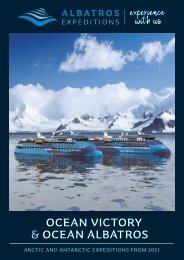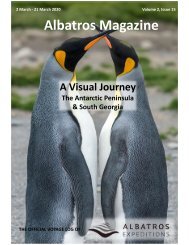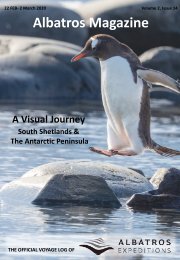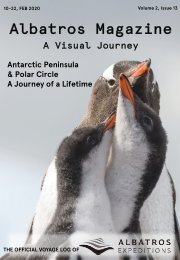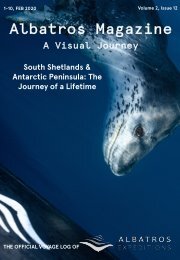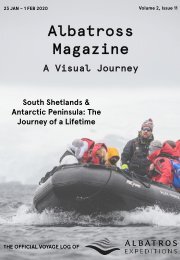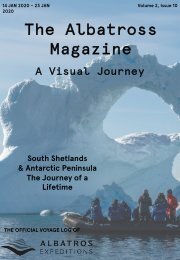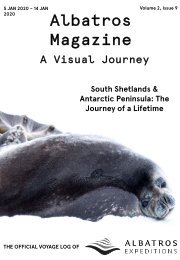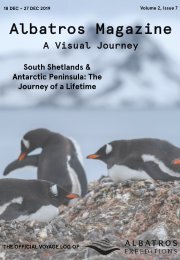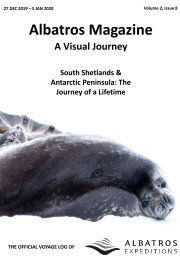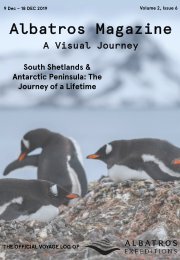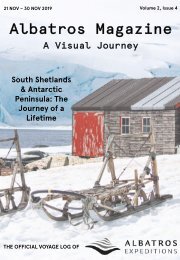South Shetlands & Antarctic Peninsula V5
- No tags were found...
Create successful ePaper yourself
Turn your PDF publications into a flip-book with our unique Google optimized e-Paper software.
30 NOV – 9 DEC 2019 Volume 2, Issue 5<br />
Albatros Magazine<br />
A Visual Journey<br />
<strong>South</strong> <strong>Shetlands</strong> &<br />
<strong>Antarctic</strong> <strong>Peninsula</strong>: The<br />
Journey of a Lifetime<br />
THE OFFICIAL VOYAGE LOG OF
Albatros Magazine: A Visual Journey<br />
Editor-in-Chief:<br />
Layout & Design:<br />
Gaby Pilson<br />
Gaby Pilson<br />
Front Cover Image:<br />
Back Cover Image:<br />
Photography Contributors:<br />
Chinstrap Penguin © Yuri Choufour<br />
Chinstrap Penguin © Renato Granieri<br />
Yuri Choufour<br />
Werner Kruse<br />
Renato Granieri<br />
Gaby Pilson<br />
30 Nov – 9 Dec, 2019 Volume 2, Issue 5
TABLE OF CONTENTS<br />
The Voyage<br />
Meet the Team<br />
Day 1: <strong>South</strong>ward Bound<br />
The Seven Sisters of Szczecin<br />
An Unlikely <strong>Antarctic</strong> Explorer<br />
Day 2: Rolling Our Way <strong>South</strong><br />
Penguins! Fun Facts for the <strong>Antarctic</strong><br />
Adventurer<br />
Day 3: At Sea in the <strong>South</strong>ern Ocean<br />
Ice is Nice – Glacier Fun Facts<br />
Whales: Friendly Giants of the Sea<br />
Day 4: The White Continent<br />
The Geological Structure of the <strong>Antarctic</strong><br />
<strong>Peninsula</strong><br />
Day 5: Travelling Through History<br />
When and How the Earth Got Cold<br />
Day 6: True <strong>Antarctic</strong> Conditions<br />
Day 7: The Final Day<br />
A Brief History of the Zodiac<br />
<strong>Antarctic</strong>a: A Continent for Science<br />
Day 8: Northward Bound<br />
Fire in the <strong>Antarctic</strong><br />
Day 9: The Beagle Channel<br />
King of the <strong>South</strong>ern Winds<br />
Day 10: Home Again<br />
By the Numbers<br />
A Final Note<br />
3<br />
4<br />
5<br />
6<br />
7<br />
8<br />
9<br />
10<br />
11<br />
13<br />
14<br />
15<br />
16<br />
17<br />
19<br />
20<br />
21<br />
23<br />
24<br />
25<br />
26<br />
27<br />
29<br />
30<br />
31
The Voyage<br />
3<br />
The following map traces the approximate route that the M/V Ocean Atlantic took during our<br />
voyage to <strong>Antarctic</strong>a. You can find more information about our day to day activities, landings, and<br />
excursions on the following pages. We hope that this magazine serves as a reminder of all of the<br />
wonderful memories you made while experiencing the <strong>Antarctic</strong> with us at Albatros Expeditions.<br />
© Renato Granieri<br />
© Yuri Choufour<br />
30 Nov – 9 Dec, 2019<br />
Volume 2, Issue 5
Meet the Team<br />
4<br />
Jamie Watts<br />
Assistant Expedition<br />
Leader<br />
Shelli Ogilvy<br />
Expedition Leader<br />
Christophe Gouraud<br />
Assistant Expedition<br />
Leader<br />
Chris Guzzo<br />
Zodiac Master<br />
Gaby Pilson<br />
Snowshoe Master<br />
Slava Nikitin<br />
Kayak Master<br />
Amanda Dalsgaard<br />
Equipment Master<br />
Nadine Smith<br />
Shop Manager<br />
Rose Li<br />
Translator & Guide<br />
Guillaume de Remacle<br />
Lecturer & Guide<br />
Yuri Choufour<br />
Photographer<br />
Sarah Bouckoms<br />
First Aid Responder<br />
Federico Campanelli<br />
Snowshoe Guide<br />
Mariam Pousa<br />
Lecturer & Guide<br />
Phil Hunter<br />
Kayak Guide<br />
Daniel Wu<br />
Translator & Guide<br />
Thomas Bauer<br />
Lecturer & Guide<br />
Ye Li<br />
Shop Assistant<br />
Aaron Strahlke<br />
Lecturer & Guide<br />
Kristoffer Ronning<br />
Lecturer & Guide<br />
Rashidah Lim<br />
Expedition Guide<br />
Marc Jansen<br />
Guest Services<br />
30 Nov – 9 Dec, 2019<br />
Volume 2, Issue 5
5<br />
<strong>South</strong>ward Bound<br />
30 November 2019 - Embarkation Day<br />
As our flights touched down on the runway in<br />
Ushuaia, we were treated to delightful views of<br />
Tierra del Fuego and the city that marks the start of<br />
our <strong>Antarctic</strong> adventure. Weary from our recent<br />
flights, yet excited for the adventure to come, we<br />
made our way to the port of Ushuaia.<br />
Walking down the long commercial pier in Ushuaia,<br />
we got our first sighting of the ship that would<br />
become our home for the next ten days – the M/V<br />
Ocean Atlantic. After snapping some photos of our<br />
trusty chariot, we embarked the Ocean Atlantic,<br />
receiving a warm welcome from the ship’s hotel<br />
department and our Expedition Team.<br />
Upon arriving in the lobby of the Ocean Atlantic, we<br />
were accompanied up to Viking Lounge where we<br />
checked in to the hotel and shown to our cabins.<br />
Soon enough, we head back up to the Nordic Coffee<br />
Bar for a scrumptious afternoon tea before the<br />
evening’s festivities. Not long after we had our last<br />
cup of tea and, perhaps, one scone too many, it was<br />
time for our mandatory safety drill in the late<br />
afternoon.<br />
After our safety drill, we had an opportunity to wander<br />
around the ship and acquaint ourselves with our new<br />
home. Before long, however, we gathered up in the<br />
Viking Lounge yet again for an introductory briefing<br />
with Expedition Leader Shelli Ogilvy and her 21<br />
expedition team staff members before heading to the<br />
first of many fantastic dinners in the Vinland<br />
Restaurant.<br />
Soon enough, we were casting away the bowlines,<br />
heading away from our safe harbour, and journeying<br />
out to sea, in true expedition style. As we’re on an<br />
expedition, we know full well that there are no<br />
guarantees. We are at the mercy of the weather, the<br />
wildlife, and the landscape of this cold and often<br />
inhospitable place.<br />
But, as explorers know all too well, we can only ever<br />
experience true beauty in nature when we are brave<br />
enough to seek it out amongst the mountains and the<br />
seas in the world’s most remote places. It is with that<br />
sentiment in mind that we venture away from Ushuaia<br />
and south, to the future and all the wonders it holds.<br />
“<br />
We can only ever experience true<br />
beauty in nature when we are<br />
brave enough to seek it out…<br />
”<br />
30 Nov – 9 Dec, 2019 Volume 2, Issue 5
The Seven Sisters of Szczecin<br />
David MacDonald, Lecturer (Geology) & Expedition Guide<br />
M/V Ocean Atlantic was launched in 1986 as the last-built of the ‘Shoshtakovich’ class of ice-strengthened<br />
passenger vessels, alongside six sister ships, together known as the “Seven Sisters of Szczecin.<br />
6<br />
Her original name was Konstantin Chernenko<br />
(Константин Черненко), after the President of the<br />
USSR (1984-1985). She was renamed Russ (Русс) in<br />
1989, and spent much of her life working in the Russian<br />
Far East.<br />
She was purchased by Albatros Expeditions and<br />
completely refitted in 2017. She is now a 200-<br />
passenger expedition vessel and is one of the strongest<br />
polar cruise ships afloat. Here are some fun facts about<br />
the “Seven Sisters”:<br />
• All seven ships were built by Stocnia Szczecinska<br />
shipyard in Szczecin, Poland between 1979-1986<br />
• Main engines: 4 x Skoda Sulzer 6LZ40 total power<br />
12800 kW, giving a maximum speed of 18 knots<br />
• Most of the class have one bow thruster (736 kW)<br />
and one stern thruster (426 kW); however, two<br />
ships, including ours, built in 1986, have two stern<br />
thrusters, each of 426 kW<br />
• Feature Siemens stabilisers for seaworthiness<br />
• Although built as ferries, they have a strengthened<br />
car deck for transport of tanks<br />
• Two of them had diving chambers<br />
• MV Mikhail Sholokov had hull demagnetising<br />
equipment so it could operate in minefields<br />
• All of these ships have been scrapped except ours<br />
and Konstantin Simonov – now Ocean Endeavour<br />
Our ship has had a complex history:<br />
1986-1987 In Baltic traffic, then Vladivostok to<br />
Japan & S Korea<br />
1989 renamed to Russ<br />
1997-1999 In traffic Stockholm-Riga; 2000<br />
Odessa-Haifa; 2002 back to<br />
Vladivostok transporting cars from<br />
Japan<br />
2007 Sold to Sea Ferry Shipping in Majuro<br />
and renamed 2010 to Atlantic;<br />
renovations in Italy and in traffic<br />
Stockholm-Helsinki-St. Petersburg<br />
during summer and laid up (October<br />
2010) in St Petersburg<br />
2012 Sold to ISP in Miami and renamed to<br />
Ocean Atlantic under Marshall<br />
Islands flag<br />
2013 Used as a hotel ship in the German<br />
bight wind farm project<br />
2015-2017 Laid up in Helsingborg and taken to<br />
Gdansk in Poland, where totally<br />
refitted<br />
2017 Chartered to Quark Expeditions<br />
2017-present Chartered to Albatros Expeditions.<br />
30 Nov – 9 Dec, 2019<br />
Volume 2, Issue 5
An Unlikely <strong>Antarctic</strong> Explorer<br />
Gregers Gjersøe – Snowshoe Master & Expedition Guide<br />
In a suburb of Wellington, New Zealand, the local<br />
cemetery is home to a rather unassuming grave.<br />
The final resting place of Henry “Chippy” McNish,<br />
one of the survivors of Sir Ernest Shackleton’s<br />
1914 Endurance Expedition, the grave is also a<br />
memorial to one of the most improbable of<br />
<strong>Antarctic</strong> explorers.<br />
In January of 1915, the Endurance got trapped in<br />
the <strong>Antarctic</strong> pack ice. McNish's work prevented<br />
the ship from flooding, but he couldn’t do<br />
anything to stop it from being crushed. The ship<br />
was abandoned and, much to McNish’s despair,<br />
Shackleton ordered Mrs. Chippy to be shot, as<br />
they couldn’t take her on their survival journey.<br />
7<br />
McNish himself was a carpenter onboard the<br />
Endurance, though he didn’t travel alone. During<br />
the expedition, McNish brought along a cat that<br />
followed him around like an overpossessive<br />
wife. Soon enough, the<br />
crew named the cat Mrs. Chippy,<br />
although the expedition quickly<br />
realised that Mrs. Chippy was a<br />
gentleman, not a lady.<br />
Mrs. Chippy was an unusual cat,<br />
though an avid adventurer,<br />
having climbed the Endurance’s<br />
rigging lines on several<br />
occasions. Mrs. Chippy also did<br />
some very provocative strolls<br />
across the roofs of the dogs’ kennels<br />
and even once fell into the frigid water<br />
below. Thankfully, the crew heard her cries and<br />
quickly turned the ship around so they could<br />
pluck her up from the icy cold waters and get her<br />
to safety.<br />
Also onboard the Endurance was a young man -<br />
Perce Blackborow. Perce had travelled to Buenos<br />
Aires looking for new employment, but wasn’t<br />
hired; at 18, his youth and inexperience counted<br />
against him. Somehow, he managed to sneak<br />
aboard the ship, and he hid in a clothing locker<br />
for three days. Eventually, he was discovered,<br />
and Shackleton was furious with him, but was<br />
sent to work in the galley where he became great<br />
friends with Mrs. Chippy.<br />
Now, the group had to make it back to safety. For<br />
months, the expedition drifted through icy<br />
waters until they made it to Elephant Island.<br />
Once at Elephant Island, Shackleton set out<br />
in a 22-foot-long open boat and made<br />
an 800-mile crossing through the<br />
rough waters of the <strong>South</strong> Atlantic<br />
to <strong>South</strong> Georgia. McNish was<br />
one of the five men who<br />
accompanied Shackleton,<br />
making improvements to the<br />
boat to make the voyage<br />
possible.<br />
For the next fifteen years, McNish<br />
lived a difficult life in Wellington<br />
before passing away in 1930. He never<br />
forgave Shackleton for shooting Mrs.<br />
Chippy.<br />
Nearly 30 years later, in 1959, the New Zealand<br />
<strong>Antarctic</strong> Society realised that McNish had been<br />
given a very poor burial in an unmarked grave.<br />
The Society raised funds for a headstone and<br />
even reunited McNish and Mrs. Chippy by adding<br />
a life-sized bronze statue of Mrs. Chippy to the<br />
grave.<br />
Now Karori Cemetery near Wellington is a<br />
pilgrimage site for <strong>Antarctic</strong> history buffs, who<br />
visit McNish’s grave and see Mrs. Chippy<br />
watching over him once again.<br />
30 Nov – 9 Dec, 2019<br />
Volume 2, Issue 5
Rolling Our Way <strong>South</strong><br />
1 December 2019 – Drake Passage<br />
The Ocean Atlantic cleared the Beagle Channel and left<br />
the shelter of the islands of Cape Horn overnight,<br />
beginning our passage across the open ocean. The<br />
Drake Passage was rough off the bat and the westward<br />
swell had us rocking through the small hours. Some<br />
found this comforting; others considered strapping<br />
themselves to their bunks. The day began officially at<br />
07:15 with Shelli’s melodious double good morning<br />
wake up call.<br />
This was followed by breakfast and a wonderful<br />
lecture by our ornithologist onboard, Guillaume,<br />
discussing the numerous different adaptations of the<br />
seabirds of the <strong>South</strong>ern Ocean. After this lecture, we<br />
headed down to the mudroom to receive our beautiful<br />
blue parkas, which will keep us toasty warm during our<br />
time in <strong>Antarctic</strong>a.<br />
As the morning rolled on, we took the time to rest and<br />
relax, especially if the rough seas had us feeling<br />
unwell. Others spent lots of time on deck or on the<br />
bridge, enjoying the spectacular array of seabirds<br />
flying through the turbulent air of the <strong>South</strong>ern Ocean.<br />
Meanwhile, our resident photographer and expedition<br />
guide, Yuri, gave us some of his top tips for getting that<br />
perfect shot in his introductory photography lecture.<br />
8<br />
After plenty of bird and photography talk, we<br />
reconvened in the Vinland Restaurant to enjoy a<br />
beautifully prepared lunch. Once lunch was done and<br />
dusted, we had our first mandatory briefing of the<br />
voyage: the IAATO briefing. Designed to help us be<br />
good tourists to <strong>Antarctic</strong>a, the IAATO briefing outlined<br />
all of the dos and don’ts of enjoying the White<br />
Continent.<br />
The IAATO briefing was followed by a mandatory<br />
biosecurity event, where we cleaned and prepared all<br />
of our jackets and bags in preparation for our upcoming<br />
<strong>Antarctic</strong> excursions. Afternoon tea, and perhaps an<br />
afternoon nap, took up most of the pre-dinner hours,<br />
though recap and the next day’s briefing brought<br />
everyone back to the Viking lounge before we all<br />
departed to the restaurant for another delicious meal<br />
together.<br />
With the anticipation high for the coming day’s<br />
activities, we capped things off with a relaxed evening<br />
in the Viking Lounge. The expedition team hosted a<br />
Hollywood-style movie night complete with popcorn.<br />
The heroes of the silver screen along with the Drake’s<br />
steady roll lulled us into a comfortable night’s sleep<br />
before another day on the Drake Passage.<br />
30 Nov – 9 Dec, 2019<br />
Volume 2, Issue 5
Penguins! Fun Facts for the <strong>Antarctic</strong> Adventurer<br />
Gaby Pilson, Hiking Master & Expedition Guide<br />
For many of us, the chance to see penguins waddling around in the snowy vastness of <strong>Antarctic</strong>a is the reason<br />
that we came to the White Continent. These charismatic sea birds are a fan-favourite for visitors to <strong>Antarctic</strong>a,<br />
but even cuddly-looking penguins are incredibly well adapted to one of the harshest environments on Earth.<br />
1<br />
2<br />
Depending on what book you read, there are 19<br />
species of penguins. If you count all of the<br />
subspecies, there are 25 total varieties of<br />
penguins in the world, however, there are only<br />
four truly <strong>Antarctic</strong> species of penguins: the<br />
Adélie, Gentoo, Chinstrap, and Emperor. All of<br />
the other penguins in the world live south of the<br />
equator yet north of <strong>Antarctic</strong>a, with the<br />
exception of one species in the Galapagos whose<br />
range barely crosses into the northern<br />
hemisphere.<br />
The largest penguin to have ever lived was the<br />
now-extinct mega penguin, which weighed some<br />
115 kg. These days, the largest penguin is the<br />
Emperor Penguin, which tips the scales at 23 kg.<br />
Alternatively, the smaller gentoo penguin weighs<br />
just 15 kg.<br />
9<br />
3<br />
4<br />
5<br />
Although they nest, breed, and socialize on land,<br />
penguins rely on the sea for survival. As<br />
swimming and diving birds, penguins are adept<br />
at fishing and must head to the ocean for their<br />
sustenance. Indeed, the deepest diving bird in<br />
the world is the Emperor Penguin, with a<br />
record-breaking dive of 535 meters!<br />
Penguins are amazing swimmers. They spend<br />
much of their day searching for food in the<br />
ocean, particularly for their favourite meal of<br />
krill, squid, and small fish. The fastest swimming<br />
penguin is the Gentoo, which is known to reach<br />
speeds of upwards of 50 kilometres and hour<br />
while zooming through the water.<br />
Penguins are highly social birds, choosing to<br />
nest in large colonies, where they will also raise<br />
their young. Many penguin chicks, after<br />
hatching stay with their parents for a few weeks<br />
to a few months before forming large “crechés,”<br />
many hundreds of individual teenage penguins<br />
in size.<br />
30 Nov – 9 Dec, 2019<br />
Volume 2, Issue 5
At Sea in the <strong>South</strong>ern Ocean<br />
2 December 2019 – Drake Passage<br />
10<br />
We awoke to a gentler rocking lullaby of the waves and<br />
Shelli’s “welcome to the day” after our first official<br />
night at sea. After breakfast, we had a lecture on<br />
penguins, where we learned all about the cute, cuddly<br />
seabirds we hoped to encounter on the White<br />
Continent.<br />
Once we wrapped up the lecture, we had a mandatory<br />
Zodiac briefing in the Viking Theatre, which was<br />
designed to acquaint us with the trusty boats that we<br />
planned to use to make landings and Zodiac cruises in<br />
<strong>Antarctic</strong>a. Although the morning was already actionpacked,<br />
before lunch, we even managed to sneak in a<br />
quick kayaking briefing for all of us interested in<br />
paddling in <strong>Antarctic</strong>a’s icy waters.<br />
These lectures and meetings left us in high anticipation<br />
of the end of our two-day voyage across the Drake<br />
Passage, though we still had much to do before we<br />
were ready to step foot on the White Continent.<br />
Lunch came and went, as it does on sea days, and,<br />
after which, we had a boot-fitting party where we got<br />
outfitted with our trusty rubber boots, which would<br />
later prove critical for keeping our feet dry during<br />
landings. After we got our boots, many of us gathered<br />
back up in the Viking Theatre for some educational<br />
CME presentations while others headed up to the<br />
Bistro for a stretching class with Rashida to limber up<br />
our sea legs for the coming days’ excursions.<br />
Soon enough, however, it was time to assemble in the<br />
Viking Theatre once again for our first “recap” and<br />
briefing, where Expedition Leader Shelli introduced the<br />
plans for the following day.<br />
A scrumptious dinner in the Vinland Restaurant, as well<br />
as a bar talk event rounded out the evening and the<br />
day’s activities, leaving us tired and excited for the next<br />
day’s busy schedule of landings and zodiac cruises on<br />
the White Continent!<br />
30 Nov – 9 Dec, 2019<br />
Volume 2, Issue 5
Ice is Nice – Glacier Fun Facts<br />
Gaby Pilson, Hiking Master & Expedition Guide<br />
Glaciers have, quite literally, shaped our world. Without glaciers, the rolling hills and wide valleys we know<br />
today would look very different, but it turns out that these icy giants have a much longer and more storied<br />
history than many of us would initially suspect. Here are some of the best fun facts about glaciers:<br />
11<br />
1<br />
Not just anything can be a glacier. In fact, there’s<br />
a size requirement that a piece of ice has to<br />
meet to become a glacier. Anything considered a<br />
glacier must be at least 0.1 km 2 (nearly 25 acres)<br />
in area to be worthy of the name. Although<br />
there’s a minimum size requirement to be<br />
considered a glacier, there’s no upper limit to<br />
glacierhood. The longest glacier on earth is the<br />
Lambert Glacier of <strong>Antarctic</strong>a, which measures<br />
out to some 434 km (270 mi) long. The world’s<br />
largest non-polar glacier is the Fedchenko<br />
Glacier of Tajikistan, which measures a<br />
respectable 77km (48mi) long.<br />
© Renato Granieri<br />
© Renato Granieri<br />
2<br />
Glaciers are formed by snowflakes. Although it’s<br />
crazy to think that a tiny snowflake can create<br />
something as large as a glacier, without snow,<br />
glaciers would never exist in the first place. To<br />
form a glacier, massive amounts of snow must<br />
accumulate and persist in a single location all<br />
year long for hundreds, if not thousands of<br />
years. During this time, the individual snowflakes<br />
found in the snowpack change in a process<br />
known as snowflake metamorphosis, where<br />
individual ice grains fuse together and get bigger<br />
and air bubbles get smaller. Once the icepack<br />
builds up enough mass to start flowing downhill,<br />
then, voila! We have a glacier.<br />
3<br />
Glaciers are found all over the world, not just in<br />
the polar regions. While the majority of glaciers<br />
and glacial ice is concentrated in high northern<br />
and southern latitudes, glaciers are found even<br />
near the equator, such as on Mount Kilimanjaro<br />
in Tanzania and in the mountains of Ecuador.<br />
That being said, about half of the world’s<br />
200,000 glaciers are found in one place: Alaska.<br />
There, glaciers cover a whopping 72,500 km 2<br />
(28,000 mi 2 ) of the US state’s total area. That’s a<br />
lot of ice.<br />
© Werner Kruse<br />
4<br />
Glaciers are basically really, really, really slow-moving rivers. To be considered a glacier, a large mass of ice<br />
must be physically moving downhill. This movement downhill is driven by gravity and is the main reason<br />
why glaciers also act as major agents of erosion. Since glaciers move downhill, they often remove and<br />
transport large boulders and chunks of rock, depositing them much further downhill then where they<br />
started.<br />
30 Nov – 9 Dec, 2019<br />
Volume 2, Issue 5
Drake Passage<br />
© Yuri Choufour<br />
Drake Passage<br />
© Yuri Choufour © Yuri Choufour<br />
Half Moon Island<br />
Half Moon Island<br />
© Yuri Choufour<br />
30 Nov – 9 Dec, 2019<br />
Volume 2, Issue 5
Whales: Friendly Giants of the Sea<br />
Amanda Dalsgaard – Lecturer (Marine Biology) and Expedition Guide<br />
13<br />
When one talks about whales, we must acknowledge<br />
the vast diversity of whales on earth and the<br />
uniqueness of each species. All whales fall into an<br />
order of marine mammals known as Cetaceans. The<br />
scientists who first discovered and named this order of<br />
marine mammals, used the word cetacean or<br />
‘ceatacea’ from the Greek ‘ketos,’ meaning monster.<br />
Long ago, when whales were first scientifically<br />
observed and recorded, people believed they were<br />
monsters, due to their size. Today, we know much<br />
more about the gentle giants that roam our planet’s<br />
seas, thanks to a number scientific and technological<br />
advances, our knowledge of these creatures will only<br />
continue to grow.<br />
The order Cetacea is divided into two sub-orders,<br />
Odontocete and Mysticeti. Odontocete, meaning<br />
‘toothed-whale’, includes all of the whales and<br />
dolphins with teeth. Mysticeti comes from the Latin<br />
root meaning “mustache”, and includes all of the<br />
whales that have baleen plates instead of teeth. It’s<br />
important to keep these differences in mind when<br />
trying to observe whales from a ship as this<br />
information can help identify cetaceans from far away.<br />
Since whales are marine mammals, they must breath<br />
air to survive. They do so by breathing at the water’s<br />
surface through their blow holes.<br />
Interestingly enough, however, toothed whales have<br />
only one blow hole or spout, while baleen whales have<br />
two. Plus, many whales can be identified from afar<br />
using the size and shape of their spout blow as well.<br />
For example, grey whales tend to have spouts shaped<br />
like hearts, while orcas have low bushy spouts.<br />
Another distinguishing characteristic that sets these<br />
two sub-orders apart is the way that they<br />
communicate. Odontocetes use a method of<br />
communication called echolocation. This is best<br />
described as a series or clicks and precise sounds that<br />
are then reflected back to the animal and allows the<br />
whale to ‘see’ their environment through noise. It is<br />
the same communication style used by bats in<br />
terrestrial ecosystems. Mysticetes on the other hand,<br />
communicate through a variety of low-frequency<br />
songs. These songs have been described by scientists<br />
as being beautiful, mysterious and sometimes gloomy,<br />
with the males being the most active singers of the<br />
Mysticeti clan.<br />
Regardless of the kind of whale you see however, any<br />
encounter with one of these graceful marine giants,<br />
however brief, is sure to be a memorable experience<br />
for years to come.<br />
30 Nov – 9 Dec, 2019<br />
Volume 2, Issue 5
The White Continent<br />
3 December 2019 – Danco Island and Paradise Harbour<br />
14<br />
By the early morning, the rocking and rolling of the<br />
ship had all but abated as we pulled into our<br />
anchorage in near Danco Island in the scenic Errera<br />
Channel. Danco itself is home to a sizeable population<br />
of gentoo penguins who nest on the island’s steep,<br />
rocky slopes. For us, the penguins and scenic backdrop<br />
of the Errera Channel make Danco the ideal place for<br />
our first <strong>Antarctic</strong> landing, which is precisely what we<br />
set out to do on our first morning on the White<br />
Continent.<br />
As soon as our expedition team scouted out the<br />
conditions onshore, we made our way toward Danco in<br />
our trusty Zodiacs. After a short ride to the beach, we<br />
disembarked our boats and started a nice walk up to<br />
one of the upper colony to stretch our legs and take in<br />
some of the views. Others in our group headed out on<br />
a nice Zodiac cruise, where they were treated to good<br />
sightings of penguins porpoising out of the water and<br />
even a Weddell seal napping on the snow near our<br />
landing site.<br />
Once in Paradise Harbour, the Ocean Atlantic dropped<br />
its anchor near Base Brown, a summertime-only<br />
Argentine station on a rocky point. Here, we found<br />
some of our familiar gentoo penguins, but, perhaps<br />
more importantly, we were able to make our first true<br />
landing on the <strong>Antarctic</strong> Continent itself!<br />
When we weren’t making our continental landing, we<br />
had a chance to enjoy a nice Zodiac cruise, which<br />
featured plentiful nesting <strong>Antarctic</strong> Cormorants as well<br />
as a curious molting juvenile elephant seal – the perfect<br />
end to our first day of excursions!<br />
Soon enough, we were back onboard the Ocean<br />
Atlantic in time for recap and then yet another<br />
delicious dinner, courtesy of Chef Indra and his team.<br />
After dinner, some of us enjoyed the variety<br />
programme in the Viking Theatre while others went out<br />
on deck to experience their first <strong>Antarctic</strong> sunset<br />
before heading to bed for some rest before the coming<br />
day’s adventures.<br />
After everyone got their time ashore, we headed back<br />
to the Ocean Atlantic for a scrumptious lunch, tea, and<br />
perhaps a nap during our quick transit out of the Errera<br />
and to the site of our afternoon excursion: Paradise<br />
Harbour.<br />
30 Nov – 9 Dec, 2019<br />
Volume 2, Issue 5
The Geological Structure of the <strong>Antarctic</strong> <strong>Peninsula</strong><br />
David Macdonald, Lecturer (Geology) & Expedition Guide<br />
This cartoon shows what the <strong>Antarctic</strong> <strong>Peninsula</strong> looked like 100 million years ago (mya). The main points to<br />
note are:<br />
• The peninsula was a continuation of the Andes. They were connected until 35 mya<br />
• The peninsula was a volcanic arc from about 200 mya3 until about 25 mya<br />
• Volcanism ended 50 mya in the south and 20 mya off Brabant Island<br />
• Only the <strong>South</strong> <strong>Shetlands</strong> Islands have any volcanic activity now<br />
15<br />
There are three main geological domains, each formed of multiple rock units:<br />
1. The basement domain (grey and brown colours) contains sediments scraped off the ocean floor which were<br />
changed by heat and pressure (metamorphosed) in the subduction zone and during folding and<br />
deformation. These metamorphic rocks span a wide range of ages from 299-65 mya. They tend to be older<br />
on the east coast of the peninsula. These rocks are best seen in Paradise Harbour, at the shag colony near<br />
Brown Station.<br />
2. The igneous domain contains rocks crystallised from magma. This includes both plutonic rocks (where the<br />
magma crystallised slowly within the earth’s crust) and volcanic rocks (where the magma was erupted as<br />
lava and ash). Again, the rocks span a wide range of ages from about 210-25 mya, and the younger rocks<br />
tend to be in the west. These are the commonest rocks seen in the <strong>Peninsula</strong> and are well displayed in the<br />
<strong>South</strong> Shetland Islands (e.g. Half Moon Island, or Yankee Harbour) or on the peninsula (e.g. Cuverville<br />
Island). Plutonic rocks form Goudier Island at Port Lockroy.<br />
3. The sedimentary domain contains rocks eroded from the volcanic arc and deposited in sedimentary basins,<br />
either on the eastern, Weddell Sea side (in a very large structure called the Larsen Basin), or in smaller<br />
basins to the west (the largest of which is the Fossil Bluff Basin on Alexander Island). Sedimentary rocks are<br />
not seen on most peninsula cruises (unless they visit the area of James Ross Island), although there are<br />
sedimentary rocks with abundant fossils interbedded with volcanic rocks west of Hannah Point, in Walker<br />
Bay.<br />
30 Nov – 9 Dec, 2019<br />
Volume 2, Issue 5
Travelling Through History<br />
4 December 2019 – Port Lockroy & Lemaire Channel<br />
Through the night and the early morning hours, we<br />
sailed down the famously beautiful Neumayer<br />
Channel, before arriving at our morning’s excursion<br />
site: the famous penguin post office at Port Lockroy.<br />
Before we could head out to land, however, we were<br />
treated to an informational lecture by Guillaume, one<br />
of our expedition guides who had spent the last<br />
<strong>Antarctic</strong> summer working at the station and had<br />
plenty of wisdom and advice to share for our visit.<br />
Soon enough, it was time for us to make our own<br />
landings at Port Lockory and, upon arrival, we could<br />
see why the charming and tiny island had a fabulous<br />
museum and gift shop – previously known as British<br />
Base ‘A’ during the Second World War. The base’s gift<br />
shop and resident penguin inhabitants were full of<br />
activity as we purchased souvenirs while the penguins<br />
incubated their eggs and stole each other’s stones.<br />
Once we had our fill of the landing site, we headed out<br />
on a short Zodiac cruise around Jougla Point and<br />
Goudier Island, where we even saw some crabeater<br />
and Weddell Seals resting on some sea ice. With our<br />
packs weighted down under the mass of our souvenirs,<br />
we headed back to the Ocean Atlantic for lunch and<br />
some relaxation before our afternoon activities.<br />
16<br />
As soon as the Ocean Atlantic raised its anchor and set<br />
sail once again through the Neumayer Channel, we<br />
began our southbound voyage toward Port Charcot and<br />
the Lemaire Channel. After a few hours of sailing, we<br />
finally made it to the mouth of the scenic Lemaire<br />
Channel, whose 7km long and less than 1km wide<br />
passage makes for a stunning southbound transit<br />
through <strong>Antarctic</strong>a’s icy waters.<br />
The White Continent lived up to its name, however, as<br />
we entered the Lemaire and were greeted by a large<br />
flow of drift ice blocking the channel’s northern access<br />
and a sizeable iceberg blocking the Lemaire’s southern<br />
exit. Under the skilled watch of our Captain, however,<br />
the Ocean Atlantic made her way through these<br />
difficult waters – much to the delight of all on deck –<br />
and to Port Charcot.<br />
Due to time of day, we decided against an evening<br />
landing, however, and, instead, made time for a quick<br />
polar plunge. Some 36 of our number jumped into<br />
slightly above-freezing water at Port Charcot while<br />
others watched from the safety of Deck 7, marking the<br />
end of yet another great day in <strong>Antarctic</strong>a!<br />
© Gaby Pilson<br />
30 Nov – 9 Dec, 2019<br />
Volume 2, Issue 5
When and How the Earth Got Cold<br />
David Macdonald, Lecturer (Geology) & Expedition Guide<br />
The Earth’s climate has two end-member states:<br />
greenhouse and icehouse. In a greenhouse climate,<br />
there are no polar icecaps (although there may be<br />
valley glaciers in high mountain areas) – the climate of<br />
the Cretaceous Period (144-65 million years ago) is a<br />
typical greenhouse. We are currently in an icehouse<br />
climate, since there are icecaps at or near both poles.<br />
Although life on Earth goes back 3.5 billion years, the<br />
main expansion in numbers of species and hence of<br />
easily found fossils occurred 540 million years ago.<br />
During the time from then until now, greenhouse<br />
climates have dominated, with three periods of<br />
icehouse climate, lasting a total of about 100 million<br />
years. Our current icehouse period began abruptly 35<br />
million years ago, with formation of an icecap in<br />
<strong>Antarctic</strong>a. Why did it happen then, and why did it have<br />
such an abrupt beginning?<br />
Water temperature (°C)<br />
<strong>Antarctic</strong> convergence<br />
October 2019<br />
8<br />
6<br />
4<br />
2<br />
0<br />
54 56 58 60 62 64<br />
Latitude (°S)<br />
17<br />
Figure 2: Temperatures in the Drake Passage from Friday 25<br />
October to Sunday 27 October 2019 as Ocean Atlantic sailed south<br />
across the <strong>Antarctic</strong> Convergence, where the sea temperature falls<br />
below 4°C.<br />
It was the severing of the link between the <strong>Antarctic</strong><br />
<strong>Peninsula</strong> and Tierra del Fuego that allowed deep cold<br />
water to circulate around the planet at 50-60°S and<br />
thermally isolate <strong>Antarctic</strong>a from the rest of the world.<br />
This situation continues today (Figure 1)<br />
The key area for this was the Drake Passage, which is<br />
the western end of the Scotia Sea (Figure 3). Geological<br />
and geophysical studies of the sea floor show that the<br />
<strong>Antarctic</strong>a-<strong>South</strong> America link was severed by the<br />
growth of ocean crust, beginning 35 million years ago.<br />
Opening of this deep-water gateway cooled the planet<br />
and turned <strong>Antarctic</strong>a into the white continent.<br />
Figure 1: Thermal structure of the <strong>South</strong>ern Ocean showing the<br />
position of the <strong>Antarctic</strong> Convergence (Polar Front) at the junction<br />
of the dark blue and mid blue shading. This is the line of the 4°C<br />
isotherm, where <strong>Antarctic</strong> surface water plunges below cold<br />
temperate water.<br />
The first, and most important factor was that we had a<br />
polar continent. <strong>Antarctic</strong>a was in roughly its present<br />
position over the <strong>South</strong> Pole, so would have had<br />
strongly differentiated winters and summers. However,<br />
although the former supercontinent of Gondwana had<br />
largely broken up by then, there was still a land bridge<br />
to <strong>South</strong> America and <strong>Antarctic</strong>a was still forested,<br />
probably with a migratory fauna. Warm currents bathed<br />
<strong>Antarctic</strong>a’s shores and, 35 million years ago, the<br />
temperature of the <strong>South</strong>ern Ocean was a relatively<br />
mild 6°C.<br />
30 Nov – 9 Dec, 2019<br />
Figure 3: The Drake Passage and the Scotia Sea formed from 50<br />
million years ago, when there was slow extension between <strong>South</strong><br />
America and the <strong>Antarctic</strong> <strong>Peninsula</strong> which stretched the crust and<br />
allowed surface waters to circulate through this former land<br />
bridge. The temperature of the southern Ocean fell from 12°C to<br />
6°C between 50-35 million years ago, then abruptly fell to 0°C<br />
when the deep water gateway of the scotia Sea opened, sundering<br />
the link between <strong>Antarctic</strong>a and <strong>South</strong> America and allowing<br />
continuous circulation of deep water, thermally isolating<br />
<strong>Antarctic</strong>a.<br />
Volume 2, Issue 5
Half Moon Island<br />
© Yuri Choufour<br />
Deception Island<br />
© Yuri Choufour<br />
Half Moon Island<br />
© Yuri Choufour<br />
Half Moon Island<br />
© Yuri Choufour<br />
30 Nov – 9 Dec, 2019<br />
Volume 2, Issue 5
True <strong>Antarctic</strong> Conditions<br />
5 December 2019 – Damoy Point & Melchoir Islands<br />
On our third day of excursions, we were starting to get<br />
used to our routine: an early morning wake up, zodiac<br />
embarkation, landings, and recap, but all of that<br />
couldn’t prepare us for the excitement of the day<br />
ahead. Although our original plan had us landing at the<br />
beach of Damoy Point in Dorian Bay, the morning’s<br />
true <strong>Antarctic</strong> conditions meant that a large flow of<br />
drift ice was blocking the entrance to the bay, forcing<br />
us to look for an alternative.<br />
Luckily, our skillful and knowledgeable expedition<br />
team knew of an alternative landing site at Damoy,<br />
where we could land right at the base of one of the<br />
island’s larger gentoo colonies without having to<br />
navigate through difficult and icy conditions. When we<br />
weren’t on land, we enjoyed a short Zodiac cruise<br />
through some scenic icebergs while also getting a<br />
chance to observe our friendly gentoos jumping in and<br />
out of the water.<br />
Once back on the Ocean Atlantic, we started our long,<br />
five-hour transit north, away from the <strong>Peninsula</strong> and<br />
toward the Melchoir Islands. This small collection of<br />
rocky outcrops nestled between Anvers and Brabant<br />
Islands would be the site of our afternoon’s Zodiac<br />
cruise, but, first, we had to cross quite a distance to<br />
get to that point.<br />
19<br />
Meanwhile, back on the ship, many of us enjoyed a<br />
relaxed lunch, as well as a lecture from our on-board<br />
marine biologist, Amanda, about the seals of the<br />
<strong>Antarctic</strong>. After the lecture, many of us headed out on<br />
deck for some bird and whale watching while others<br />
found that the rolling and rocking of the ship in the swell<br />
of the Gerlache Strait kept us in our cabins until we<br />
reached our anchorage at the Melchior Islands.<br />
Upon arrival, the initial wind and the swell in the waters<br />
of the Melchoirs caused some concern, but our<br />
experienced Zodiac drivers felt confident in their ability<br />
to handle the conditions. Luckily enough for us, however,<br />
the wind and the swell more or less abated, and we<br />
enjoyed a stunning cruise in the bright sunshine and<br />
even spotted a handful of Weddell Seals before heading<br />
back to the ship.<br />
While we weren’t cruising, our expedition guide and<br />
resident glaciologist, Gaby, gave an informative lecture<br />
on the icy wonders of the White Continent to help us<br />
better understand the landscapes around us. Once back<br />
on the ship, we enjoyed a quick recap and briefing about<br />
our final day in <strong>Antarctic</strong>a, before heading off to dinner<br />
in the Vinland Restaurant. What a day!<br />
30 Nov – 9 Dec, 2019<br />
Volume 2, Issue 5
The Final Day<br />
6 December 2019 – Half Moon Island and Deception Island<br />
Today’s adventures began at a scenic little volcanic<br />
cove known to <strong>Antarctic</strong> expeditioners as Half Moon<br />
Island. The weather was in our favor and we were able<br />
to proceed with the daily plan of a morning landing<br />
and a zodiac cruise. The landing site was filled with an<br />
abundance of nesting sea birds and chinstrap<br />
penguins, alike, with a few gentoo penguins spread<br />
amongst the colonies.<br />
While half the group was exploring on land, the other<br />
half embarked upon a zodiac cruise to experience the<br />
rugged shoreline of Half Moon Island that is not<br />
accessible by foot. We also cruised by the uninhabited<br />
Argentine Camara research station, where a resting<br />
elephant seal was spotted on the beach to greet our<br />
boats!<br />
After a beautiful morning at Half Moon island, we<br />
reconvened onboard the Ocean Atlantic and joined<br />
together for lunch inside the renowned Vinland<br />
Restaurant. During this time, the captain and his<br />
officers steered the Ocean Atlantic and began our<br />
transit to Deception Island’s Telefon Bay.<br />
20<br />
Deception Island is an active volcano, whose caldera is<br />
home to the epic landing site we hoped to visit that<br />
afternoon. The trip into this caldera provided all<br />
onboard with phenomenal views as we passed the<br />
world’s largest chinstrap colony at Baily Head, and as<br />
the bridge officers carefully pushed us through a rocky<br />
passageway called ‘The Bellows’. Once through the<br />
Bellows, we anchored outside of Telefon Bay, and with<br />
seemingly cooperative weather, we proceeded with<br />
our plan and landed the of our number ashore.<br />
As some of the group headed out on a walk on the<br />
island’s rocky shores, others prepared for a polar<br />
plunge into the island’s famous Port Foster. Whether<br />
we jumped into the 3 o C waters of Deception Island or<br />
enjoyed some beautiful sightings of a resting Weddell<br />
Seal and a handful of chinstrap and gentoo penguins,<br />
our sunny afternoon at Telefon Bay was one to<br />
remember as we headed back to the Ocean Atlantic<br />
and started our northbound journey away from the<br />
<strong>South</strong> <strong>Shetlands</strong>, into the Drake Passage, and toward<br />
Ushuaia.<br />
30 Nov – 9 Dec, 2019<br />
Volume 2, Issue 5
Lemaire Channel<br />
© Yuri Choufour<br />
Port Lockroy<br />
© Yuri Choufour<br />
© Yuri Choufour<br />
Damoy Point<br />
© Yuri Choufour<br />
Lemaire Channel<br />
30 Nov – 9 Dec, 2019<br />
Volume 2, Issue 5
A Brief History of the Zodiac<br />
Steve Traynor, Zodiac Master<br />
In expedition cruising, the most important tool we use is the Zodiac inflatable boat. These manoeuvrable,<br />
reliable, robust vessels are the workhorse of the expedition cruise industry, from the north of Svalbard to<br />
the southern end of the <strong>Antarctic</strong> <strong>Peninsula</strong>. They have a long history – as you can see from the stages<br />
below, many different inventions needed to come together to create the craft we use today.<br />
1838 Charles Goodyear (USA) discovered the process for vulcanising rubber (a US patent was granted<br />
in 1844) – this process is used for hardening and strengthening rubber.<br />
1843 Goodyear’s process was stolen by Thomas Hancock (UK) using the process of reverse<br />
engineering; less controversially, Hancock invented the “masticator” – a machine for re-using<br />
rubber scraps – this made the rubber industry much more efficient.<br />
1845 The first successful inflatable boat (Halkett boat) was designed by Lieutenant Peter Halkett<br />
(UK), specifically for Arctic operations. Halkett Boats were used by the Orcadian explorer, John<br />
Rae, in his successful expedition to discover the fate of the Franklin Expedition.<br />
1866 Four men made the first crossing of the Atlantic Ocean from New York to Britain on a threetube<br />
inflatable raft.<br />
1896 The original Zodiac company was founded by Maurice Mallet (France) to produce airships.<br />
1909 The first outboard motor was invented by Ole Evinrude in Milwaukee, Wisconsin.<br />
1912 The loss of the Titanic and subsequent shipping losses during World War 1 proved the need for<br />
inflatable rafts for use as supplementary lifeboats.<br />
1919 RFD firm (UK) and the Zodiac company (France) started building inflatable boats.<br />
1934 The airship company, Zodiac, invented the inflatable kayak and catamaran<br />
1942 The Marine Raiders – an elite unit of the US Marine Corps – used inflatable boats to carry out<br />
raids and landings in the Pacific theatre.<br />
1950 Alain Bombard first combined the outboard engine, a rigid floor and an inflatable boat (built by<br />
the Zodiac company).<br />
1952 Alain Bombard crossed the Atlantic Ocean with his inflatable; after this, his good friend, the<br />
famous diver Jacques-Yves Cousteau, started using them.<br />
1960 Zodiac licensed production to a dozen companies in other countries because of their lack of<br />
manufacturing capacity in France.<br />
22<br />
30 Nov – 9 Dec, 2019<br />
Volume 2, Issue 5
<strong>Antarctic</strong>a: A Continent for Science<br />
David Macdonald, Lecturer (Geology) & Expedition Guide<br />
Until the advent of mass tourism, <strong>Antarctic</strong>a’s tagline was: “A continent for science”.<br />
23<br />
<strong>Antarctic</strong>a affects the rest of the world in a variety of<br />
ways, so “<strong>Antarctic</strong> Science” should really be “Global<br />
science that happens in <strong>Antarctic</strong>a”. Although many<br />
early expeditions were purely geographical in scope,<br />
there were some important scientific expeditions in the<br />
late 19 th to early 20 th centuries. In this “Golden Age” of<br />
exploration, there were many scientific contributions<br />
from <strong>Antarctic</strong>a which changed our view of the earth’s<br />
evolution and environment.<br />
Indeed, three expeditions brought back proof that<br />
<strong>Antarctic</strong>a once had a warm climate. Scott’s first<br />
expedition (1901-1904) found coal from 250 million<br />
years ago in the Transantarctic Mountains;<br />
Nordenskjӧld’s Swedish <strong>Antarctic</strong> Expedition found<br />
warm-water fossils on James Ross Island; and the Scotia<br />
Expedition under Bruce (1902-1904) dredged<br />
fossiliferous 500 million-year-old limestone from the<br />
Weddell Sea. Scott’s second expedition (1910-1913)<br />
found fossil leaves(Glossopteris) in the Transantarctic<br />
Mountains. These fossils belong to an extinct order of<br />
seed ferns from 299-252 million years ago, only found<br />
in the southern hemisphere continents and India. They<br />
were used by Wegener in 1924 in his work on<br />
continental drift to reconstruct the former<br />
supercontinent of Gondwana.<br />
In the years after the First World War, the focus<br />
changed from individual expeditions to national<br />
pursuits, such as the British Discovery Investigations –<br />
the first permanent oceanographic body in the world.<br />
During 33 years (1918–51) of pioneering work, the<br />
research ships collected an enormous amount of<br />
oceanographic, biological, and geographical data.<br />
Among the results of the investigations was the<br />
discovery of both the Mid-Atlantic Ridge and the<br />
<strong>Antarctic</strong> Convergence - the natural boundary of<br />
<strong>Antarctic</strong>a.<br />
By the end of the Second World War, the move to<br />
create national organisations was complete, with the<br />
formation of the Falkland Islands Dependencies Survey<br />
(now British <strong>Antarctic</strong> Survey), the Australian National<br />
Research Expeditions) and other civilian operations<br />
(France, New Zealand, <strong>South</strong> Africa, etc).<br />
As a result of these organisations and better logistics,<br />
the rate of scientific discovery soared, and new polarspecific<br />
studies proliferated. Some highlights include:<br />
• 1957-58: The International Geophysical Year (IGY)<br />
was an 18-month collaboration between 67<br />
countries. <strong>Antarctic</strong>a was the focus, with 12 nations<br />
participating. Many new scientific stations were<br />
created and the IGY was a resounding success as it<br />
led directly to the <strong>Antarctic</strong> Treaty<br />
• 1959-1996: The discovery and delineation of<br />
subglacial Lake Vostok is a great example of scientific<br />
cooperation. Lab studies showed that ice under very<br />
high pressure reverts to water and in 1964, seismic<br />
soundings from Vostok Station were used to<br />
measure the thickness of the ice sheet. This<br />
suggested the existence of a subglacial lake. British<br />
airborne ice-penetrating radar in the 1970s detected<br />
unusual radar readings, suggesting a freshwater lake<br />
below the ice. In 1991, a radar satellite revealed<br />
that this subglacial water body is one of the world’s<br />
largest lakes. We now know that there are at least<br />
140 subglacial lakes in <strong>Antarctic</strong>a.<br />
• 1980-present: The US-funded collection and curation<br />
of <strong>Antarctic</strong> meteorites has recovered about 22,000<br />
meteorites from <strong>Antarctic</strong>a (about 75% of all known<br />
meteorites worldwide). There are samples from the<br />
Moon, Mars, and asteroids.<br />
• 1985: In hole in the ozone layer over <strong>Antarctic</strong>a was<br />
discovered from ground-based instruments at Halley<br />
Bay and Faraday (British <strong>Antarctic</strong> Survey).<br />
• 1986: Research at McMurdo Station, the main U.S.<br />
scientific station in <strong>Antarctic</strong>a, established that<br />
chlorofluorocarbons (CFCs) as the probable cause of<br />
the <strong>Antarctic</strong> ozone hole (US NSF). These two bits of<br />
work lead to signing of the Madrid Protocol on 1987,<br />
banning CFCs.<br />
30 Nov – 9 Dec, 2019<br />
Volume 2, Issue 5
Northward Bound<br />
7 December 2019 – Drake Passage<br />
As we started our journey homeward, we entered the<br />
Drake Passage. We soon experienced the same rolling<br />
of the ship that we encountered on our southbound<br />
voyage, though the gentle motion lulled everyone to<br />
sleep, until we awoke the next morning to Shelli’s<br />
typical “welcome to the day”.<br />
It was a more leisurely start, however, with Shelli<br />
allowing us to sleep in until 7:45, as we didn’t need to<br />
climb into our warm clothes, waterproofs, hat, gloves,<br />
rubber boots, and life jacket nor don our backpacks<br />
containing our selection of <strong>Antarctic</strong> essentials, extra<br />
clothes, and most important of all - our cameras.<br />
Our first day at sea was a day of entertainment on<br />
board the Ocean Atlantic, starting with CME<br />
presentations in the Viking Theatre. After another<br />
excellent lunch, our kayakers debriefed in the Viking<br />
Theatre while the rest of us headed up to the Bistro for<br />
the afternoon’s main activity: samosa making.<br />
24<br />
Once samosa making and tea time wrapped up Amanda<br />
gave a lecture on the fish and fisheries of the <strong>Antarctic</strong>,<br />
providing some more information about the mysterious<br />
world of the sea that supports all of the fantastic sea life<br />
of the White Continent.<br />
Soon enough it was time for recap, briefing, and dinner,<br />
where we got to enjoy the fruits of our culinary efforts.<br />
Then, we headed back to the Viking Theatre for a Las<br />
Vegas-themed night - a great ending to our first day at<br />
sea.<br />
Whether we were too stuffed from our delicious<br />
samosas to take part in Las Vegas night or we headed<br />
out on deck for some bird watching, we had a fantastic<br />
night on the Ocean Atlantic as we neared the end of our<br />
<strong>Antarctic</strong> journey.<br />
30 Nov – 9 Dec, 2019<br />
© Renato Granieri Photography<br />
Volume 2, Issue 5
Fire in the <strong>Antarctic</strong><br />
Gregers Gjersøe, Snowshoe Master & Expedition Guide<br />
Fire is one of the greatest threats in <strong>Antarctic</strong>a thanks<br />
to the region’s very dry climate, frequent strong winds,<br />
and nearly complete lack of liquid freshwater. Due to<br />
the continent’s isolation with and little possibility of<br />
rescue for weeks or months, a fire in the <strong>Antarctic</strong> is a<br />
potentially very disastrous event.<br />
Although it is covered in snow and ice, the cold<br />
temperatures of <strong>Antarctic</strong>a make the White Continent<br />
very dry. As it is one of the windiest places on Earth,<br />
there is almost always a strong wind blowing much of<br />
the time, more than strong enough to fan any flames.<br />
As the temperatures across the whole continent of<br />
<strong>Antarctic</strong>a is averaging below freezing, there is unlikely<br />
to be very much liquid water to fight fires. So, the<br />
response to fire is usually to make sure everyone is out<br />
of danger and safe and then stand back and watch it<br />
burn itself out.<br />
Bases in <strong>Antarctic</strong>a are often designed to survive fires<br />
because they are made up of a number of separate<br />
buildings, each with a significant distance between<br />
them. Many bases have emergency supplies stored in a<br />
hut near the base but well away. In these huts, there<br />
are often enough supplies and ample shelter for the<br />
base’s crew to be able to survive a fire or emergency<br />
until help can arrive.<br />
The Argentine <strong>Antarctic</strong> base and scientific research<br />
station, “Brown Station,” is named after Admiral<br />
William Brown, the father of the Argentine Navy.<br />
25<br />
Located on the Sanaviron <strong>Peninsula</strong> along Paradise<br />
Harbour’s Danco Coast, from 1951 to 1984 it served as<br />
a permanent research base, though, since then, it is<br />
open only during the summer season.<br />
During its heyday, the station was home to one of the<br />
most complete biology laboratories on the <strong>Antarctic</strong><br />
<strong>Peninsula</strong>, featuring a main house, as well as an<br />
additional building exclusively for scientific research.<br />
This building was equipped with three labs, a<br />
photography workshop, an emergency radio station, an<br />
office and a library.<br />
Unfortunately, Brown Station’s original facilities were<br />
burned down by the station’s doctor on 12 April 1984<br />
after he was ordered to stay on for yet another winter,<br />
despite the original terms of his contract and his desire<br />
to see his fiancé once again. As you can imagine, the<br />
stress of <strong>Antarctic</strong>a’s harsh winter conditions can take<br />
its toll on residents and explorers of the region, driving<br />
them to take extreme measures to get back home.<br />
The doctor simply couldn’t bear to stay on for another<br />
winter and he couldn’t stand the isolation as the days<br />
drew darker. His solution? To force an evacuation of<br />
himself and his colleagues in the only way plausible<br />
manner: by burning the station down.<br />
After the fire, the station’s personnel were rescued by<br />
the USS Hero and taken to United States’ Palmer<br />
Station. Argentina later rebuilt the base, but it is now<br />
only occupied during the summer months. The station’s<br />
doctor was sent to prison for arson and his fiancé<br />
decided to call off the engagement.<br />
© Werner Kruse<br />
30 Nov – 9 Dec, 2019<br />
Volume 2, Issue 5
The Beagle Channel<br />
8 December 2019 – Drake Passage<br />
On the the final morning our Drake Passage crossing,<br />
we awoke to misty skies and an abundance of seabirds.<br />
Although the seas had rocked the Ocean Atlantic<br />
through the night, by early morning, the swell had<br />
abated a bit and we had a relatively pleasant morning<br />
on the <strong>South</strong>ern Ocean.<br />
Thankfully, we had a later start for the day so we had a<br />
bit of a lie in before a scrumptious brunch and an<br />
assortment of CME presentations in the Viking Theatre.<br />
After lunch, we headed back to the Viking Theatre,<br />
where Shelli gave us a pre-disembarkation briefing.<br />
Although we all wish we could spend another ten days<br />
aboard the Ocean Atlantic in the White Continent, our<br />
bank accounts wouldn’t condone such activities, so we<br />
must prepare to bid adieu to the ship that has been our<br />
home on this amazing voyage.<br />
Once the briefing was done and dusted, we enjoyed a<br />
special afternoon tea time on the outer decks, which<br />
featured ice cream and hot chocolate as we entered the<br />
calm waters of the Beagle Channel in the early<br />
afternoon before Jamie gave an informative lecture on<br />
climate change in the polar regions.<br />
26<br />
By early evening, it was time to gather in the Viking<br />
Lounge one last time for the end of voyage slideshow<br />
and charity auction, as well as Captain Nikolay’s<br />
celebratory cocktail hour. We waved a hearty goodbye<br />
to the journey of a lifetime, taking a moment to reflect<br />
on our voyage, thanks to Yuri’s immaculately composed<br />
slideshow of our trip to the White Continent.<br />
We also had a chance to thank and appreciate the many<br />
people who made this journey possible, from the<br />
officers and crew to the Expedition Staff. Finally, it was<br />
time to head to the Vinland Restaurant for our last<br />
dinner aboard the Ocean Atlantic, topped off with Chef<br />
Indra’s spectacular “Death by Chocolate” dessert buffet.<br />
As we pulled into our berth in Ushuaia, our journey<br />
drew closer towards its close. However, as we packed<br />
our bags and prepared to disembark the Ocean Atlantic,<br />
amid the festivities of the evening, we had the chance to<br />
appreciate the beauty of the journey of a lifetime and all<br />
the memories we’ll take with us as we make our way<br />
home.<br />
30 Nov – 9 Dec, 2019<br />
© Renato Granieri Photography<br />
Volume 2, Issue 5
© Yuri Choufour<br />
Plenau Bay<br />
Damoy Point<br />
© Yuri Choufour<br />
Danco Island<br />
© Yuri Choufour<br />
Danco Island<br />
© Yuri Choufour<br />
30 Nov – 9 Dec, 2019<br />
Volume 2, Issue 5
King of the <strong>South</strong>ern Winds<br />
Sandra Ophorst, Lecturer & Expedition Guide<br />
The wandering albatross is an impressive bird with the<br />
world’s largest wingspan of up to 3.5 meters in length<br />
and a weight of up to 11 kilograms. Unfortunately, the<br />
number of wandering albatrosses is rapidly declining<br />
with only 20,100 individuals left as of October 2019<br />
(Red List, World Conservation Union)<br />
The wandering albatross is rarely seen on land and<br />
gathers only to breed, at which time it forms large<br />
colonies on remote islands, such as <strong>South</strong> Georgia. The<br />
female lays a single white egg and both sexes share<br />
incubation, which lasts about 60 to 80 days. Both sexes<br />
feed the youngster by regurgitating food, a process<br />
that can continue for up to nine months.<br />
The nesting cycle of wandering albatrosses is so long,<br />
they can’t complete it in one year. So, they nest every<br />
other year. When young albatrosses become<br />
independent and leave their nest site, they begin a<br />
multi-year foray on the open ocean and will not return<br />
to land until they are old enough to breed. This can<br />
take up to 10 years of their 50 year average lifespan.<br />
28<br />
The wandering albatross is famous for its dynamic<br />
flight. They turn into the wind to gain height, then glide<br />
back down to the sea to gain speed. Sometimes they<br />
glide for hours without rest or even a single flap of<br />
their wings. Indeed, this principle was used to design<br />
airplanes, especially gliders that have albatross-like<br />
wings.<br />
As a result of these wings, however, an albatross’<br />
landing process often looks a bit comical as their<br />
narrow wings do not allow for a slow approach. So,<br />
they often land on their feet and then tumble forward<br />
and slide on their bellies. The biggest threats to the<br />
wandering albatross are pollution and large-scale<br />
commercial tuna fisheries. These tuna fishing boats are<br />
equipped with up to 20,000 fish baited hooks and<br />
these lines can be up to 100km long.<br />
Unfortunately, these fishing lines often attract<br />
albatrosses get caught up on the hooks and drown as<br />
they are cast out at sea. Organisations such as Hookpod<br />
are trying to save the albatrosses from the dangers of<br />
long line fishing vessels by providing fishing boats with<br />
“hookpods” that cover the barb and point of the hook<br />
during setting, reducing the likelihood of an albatross<br />
by-catch.<br />
© Gaby Pilson<br />
30 Nov – 9 Dec, 2019<br />
Volume 2, Issue 5
Home Again<br />
9 December 2019 - Ushuaia<br />
After last night’s end-of-voyage festivities, we awoke<br />
much too early for our final morning on the Ocean<br />
Atlantic. Although we wish we could stay, we started<br />
the process of leaving behind the ship and the people<br />
we’ve come to know so well over the past week.<br />
Our bags were packed and stowed in the corridors,<br />
ready for our early-morning busses and flights back<br />
home. After nine whole days immersed in the<br />
landscapes and amongst the wildlife of the <strong>Antarctic</strong>,<br />
it was time to return home or to wherever our life’s<br />
journeys bring us.<br />
And so – farewell, adieu, and goodbye. Together we<br />
have visited and incredible and vast wilderness. We<br />
have experienced magnificent mountain vistas, seen<br />
icebergs roll and crack, felt the power of the elements<br />
and seen how quickly they can change. We enjoyed<br />
wonder food and comfortable surroundings aboard<br />
the Ocean Atlantic.<br />
29<br />
We boarded zodiacs and cruised through icy bays at<br />
the end of the Earth. We shared unique moments,<br />
held engaging conversations, and laughed together<br />
over beers and coffees. We’ve made new friends and<br />
experienced the power of expeditionary travel.<br />
We hope the expedition team has helped make this<br />
the trip of a lifetime - one that will persist in your<br />
memories for weeks, months, and years, to come.<br />
Although we must say good-bye to these places we<br />
have come to know and love, it is a fond farewell as<br />
we are all true ambassadors for the <strong>Antarctic</strong> and all<br />
the beauty it holds.<br />
On behalf of Albatros Expeditions, our captain and<br />
crew, the expedition team, and everyone else who<br />
helped make this journey a resounding success, it has<br />
been a pleasure travelling with you. We hope that you<br />
will come back and experience these wonderful places<br />
with us once again!<br />
30 Nov – 9 Dec, 2019<br />
Volume 2, Issue 5
By the Numbers…<br />
30<br />
Voyage Statistics:<br />
<strong>South</strong>ernmost Point:<br />
Total Distance Travelled:<br />
65 o 07.227’ S, 64 o 01.075’W<br />
1606 nautical miles<br />
Excursion Locations:<br />
Half Moon Island: 62 o 35’ S 59 o 53’ W<br />
Danco Island: 64 o 43’ S 62 o 35’ W<br />
Damoy Point: 64 o 48’ S 63 p 30’ W<br />
Deception Island: 62 o 59’ S 60 o 33’ W<br />
Port Lockroy: 64 o 49’ S 63 o 31’ W<br />
Brown Station:<br />
Melchior Islands:<br />
Port Charcot:<br />
Ushuaia:<br />
64 o 50’ S 62 o 57’ W<br />
64 o 18’ S 63 o 02’ W<br />
65 o 04’ S 64 o 02’ W<br />
54 o 45’ S 68o23’ W<br />
During our time on the M/V Ocean Atlantic, we consumed:<br />
Beef<br />
Lamb<br />
Pork<br />
Poultry<br />
Cold Cuts<br />
Fish & Seafood<br />
Eggs<br />
Milk<br />
Cheese<br />
Ice Cream<br />
Vegetables<br />
Fruit<br />
Assorted Spices<br />
Wine<br />
Beer<br />
Toilet Paper<br />
220kg<br />
600kg<br />
450kg<br />
1500kg<br />
120kg<br />
520kg<br />
7250 pieces<br />
620L<br />
120kg<br />
200L<br />
2800kg<br />
2000kg<br />
500 packages<br />
360 bottles<br />
648 cans<br />
1242 rolls<br />
30 Nov – 9 Dec, 2019<br />
Volume 2, Issue 5
A Final Note…<br />
31<br />
As any good expedition comes to a close, many of us experience the<br />
effervescent excitement that comes when we immerse ourselves<br />
completely in an adventure. Although we all came into this voyage with<br />
our own expectations and personal motivations, on the ship, we quickly<br />
learned that the best plan is the one that we end up doing.<br />
While weather and the landscape<br />
can conspire against us in the<br />
southern latitudes, the right mindset<br />
can make all of the difference.<br />
Wind, rain, sleet, and snow make no<br />
difference when we come prepared<br />
for an adventure and all the<br />
excitement it holds. Whether you<br />
saw what you came for or you<br />
experienced something else<br />
entirely, when you set out on an<br />
expedition, you come for the<br />
mountains and the wildlife, but stay<br />
for people and places you meet<br />
along the way.<br />
Although we all eventually have to<br />
leave behind our beloved Ocean<br />
Atlantic, there are always a few<br />
things we can take home from an<br />
expedition:<br />
• An acceptance and embracement<br />
of adversity and uncertainty<br />
when the natural world alters<br />
our plans.<br />
• A fondness for the wild and a<br />
strong desire to keep remote<br />
natural locations as beautiful and<br />
free as they can be.<br />
• An insatiable interest in learning<br />
more about the people, places,<br />
and cultures in some of the most<br />
remote parts of the world.<br />
As you unpack you bags, you may<br />
find souvenirs and keepsakes from<br />
your journey. Your camera may be<br />
filled with countless photos,<br />
however blurry, of the many<br />
animals and mountains that have<br />
crossed our paths. At the end of the<br />
day, however, what matters most is<br />
the experience of, the journey to,<br />
and the memories of these wild and<br />
wonderful places.<br />
Best wishes from all of us on the<br />
expedition team as you continue on<br />
with your adventures!<br />
Shelli Ogilvy<br />
Expedition Leader<br />
Jamie Watts<br />
Assistant Expedition Leader<br />
Thank you for experiencing the <strong>Antarctic</strong> with us at Albatros<br />
Expeditions. We hope to see you aboard the Ocean Atlantic<br />
again in the future!<br />
Christophe Gouraud<br />
Assistant Expedition Leader<br />
30 Nov – 9 Dec, 2019<br />
Volume 2, Issue 5




